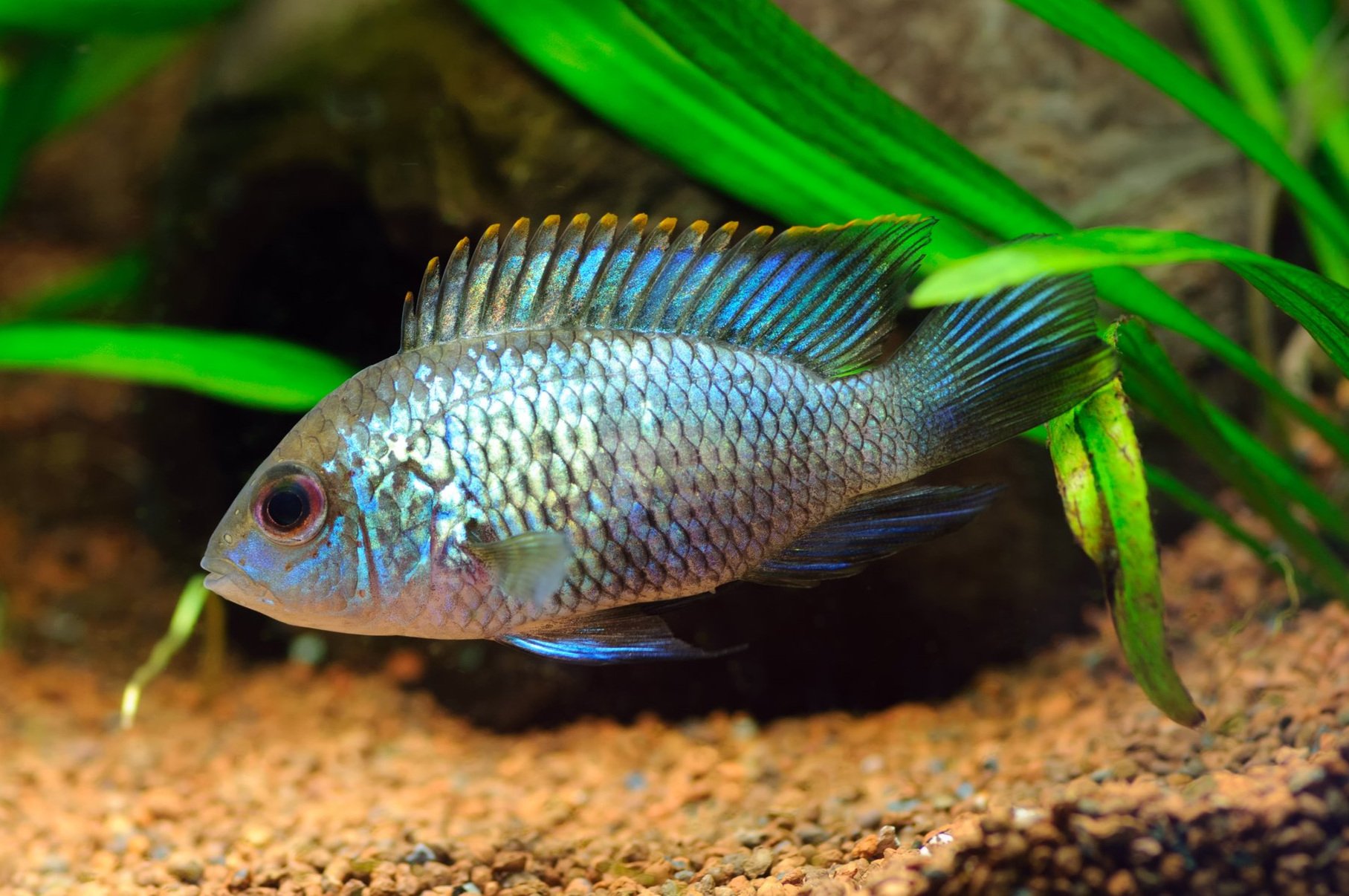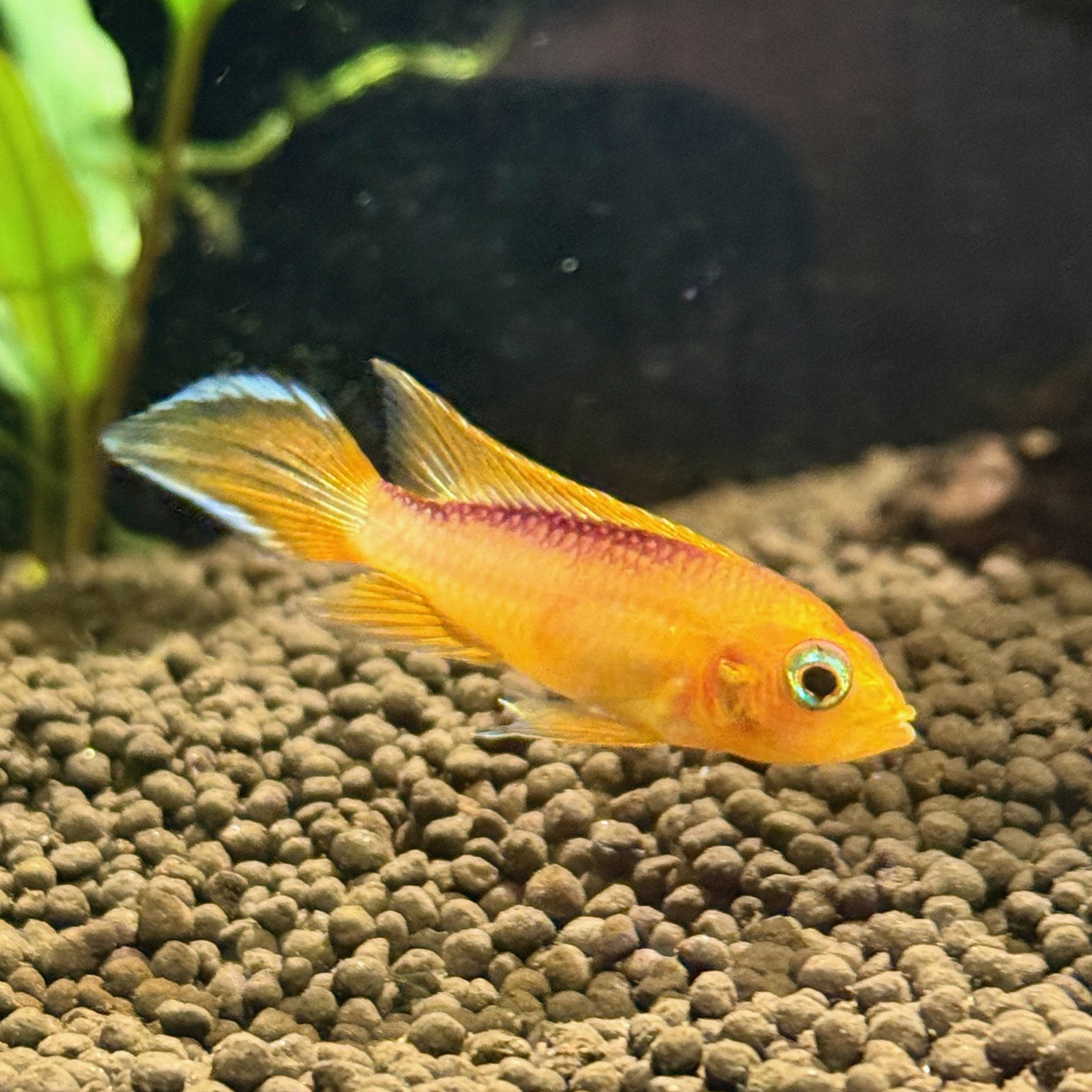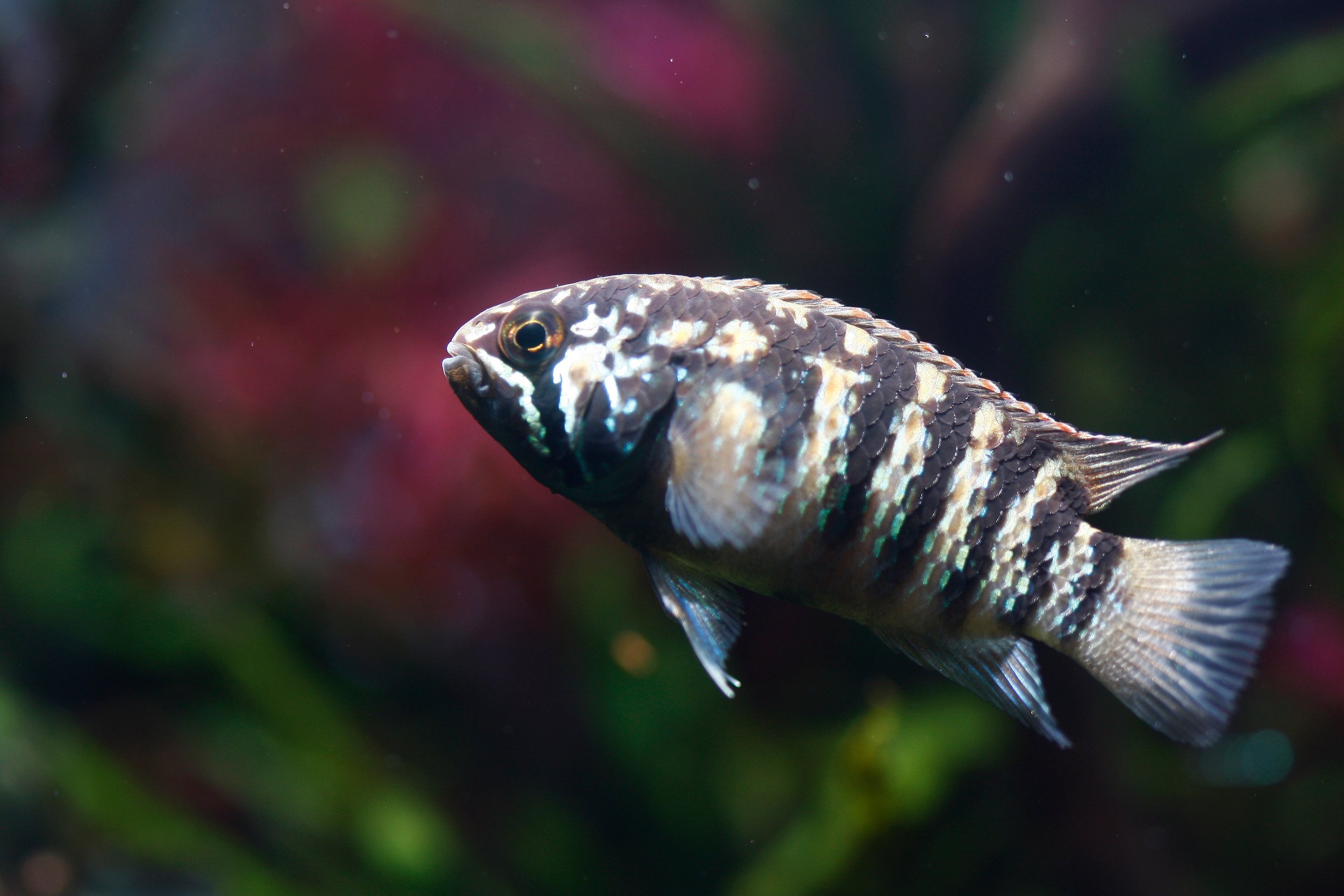 Image 1 of 3
Image 1 of 3

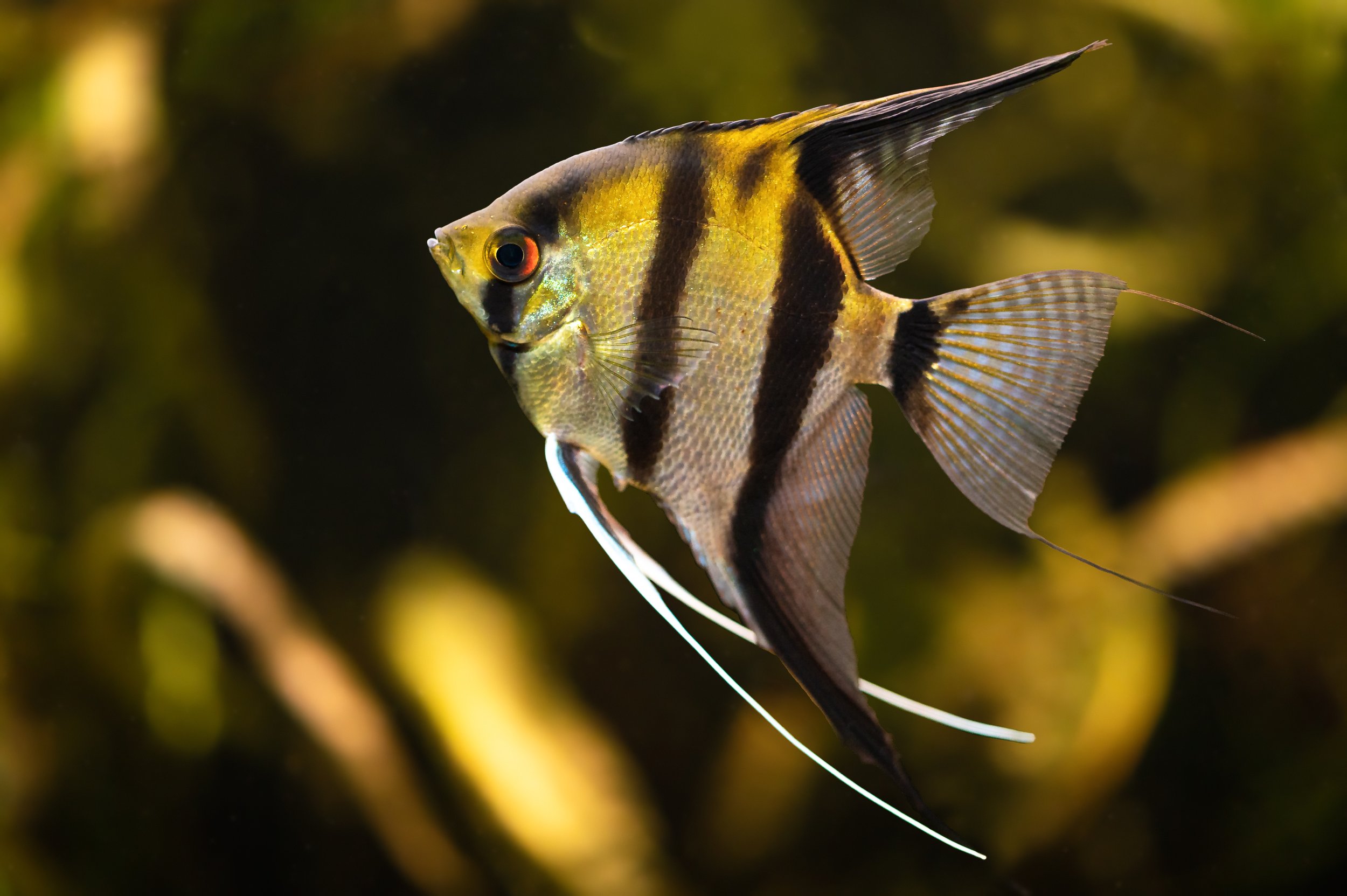 Image 2 of 3
Image 2 of 3

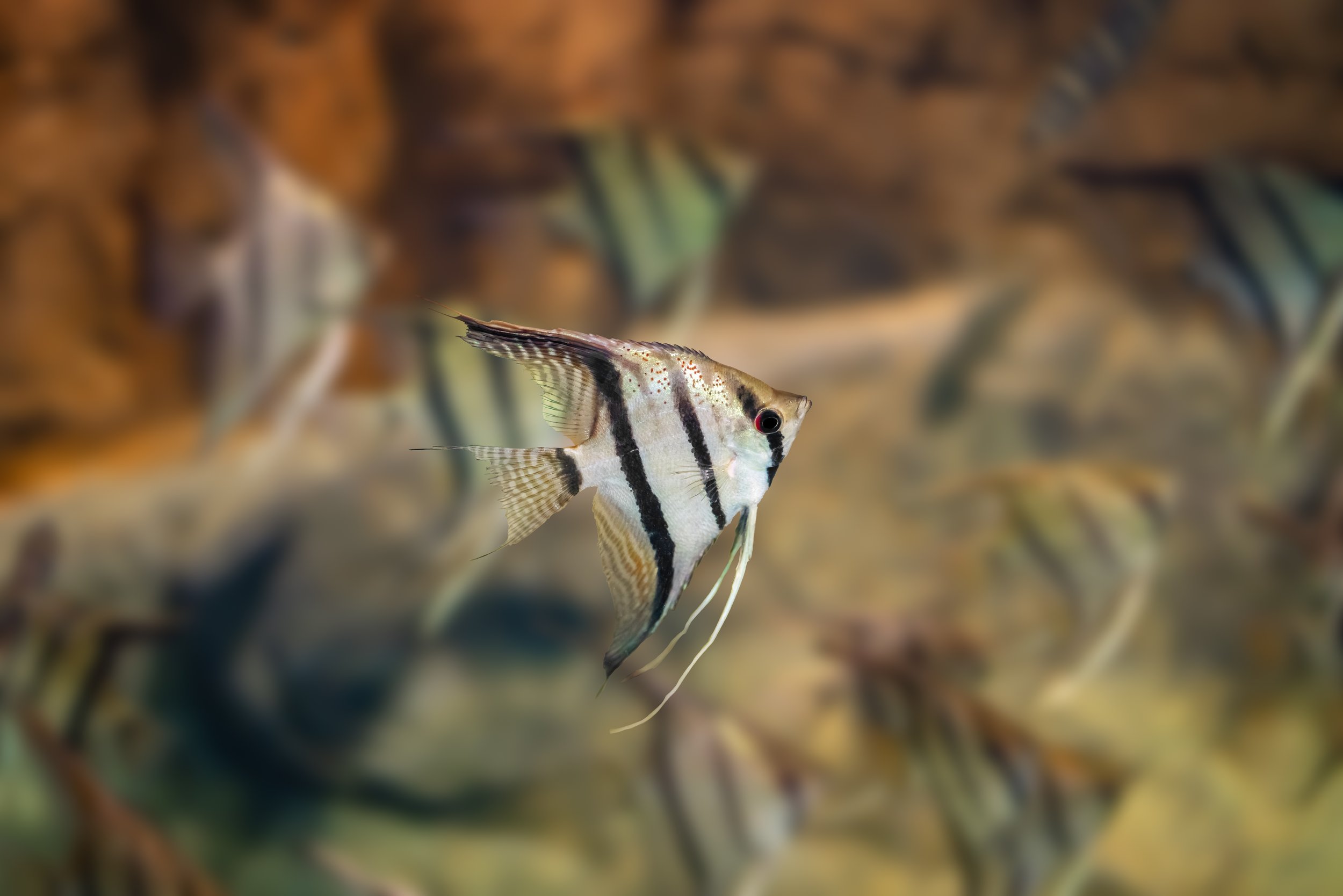 Image 3 of 3
Image 3 of 3




Silver Angelfish
Angelfish, scientifically known as Pterophyllum scalare, are one of the most iconic and popular freshwater fish species in the aquarium hobby. Native to the slow-moving rivers, floodplains, and wetlands of the Amazon Basin in South America, these elegant fish are admired for their distinctive shape, graceful swimming patterns, and striking coloration. With their tall, laterally compressed bodies and long, flowing fins, angelfish add a dramatic and sophisticated touch to any aquarium.
Physically, angelfish are characterized by their triangular body shape and elongated dorsal and anal fins, which can span several inches in height, giving them a majestic, gliding appearance in the water. Their coloration can vary greatly, with common varieties including silver with black vertical stripes, gold, marbled, and even koi-like patterns with vibrant orange and black markings. Selective breeding has also resulted in several color morphs, such as veil-tail and albino varieties. Adult angelfish can grow up to 6 inches (15 centimeters) in length and up to 8 to 10 inches (20 to 25 centimeters) in height, including their fins, making them suitable for medium to large aquariums.
In the aquarium, angelfish thrive in well-planted tanks with plenty of vertical space to accommodate their tall bodies and flowing fins. They prefer a tank with dense vegetation, driftwood, and rocks, which can provide hiding spots and break up line of sight, reducing aggression, especially in larger groups. Angelfish are generally peaceful but can be territorial, particularly when they are spawning or when kept in overcrowded conditions. Because of this, it is advisable to provide ample space, especially when housing multiple angelfish together.
Water parameters for angelfish should mimic their natural habitat in the Amazon Basin. They prefer slightly acidic to neutral water with a pH range of 6.0 to 7.5 and temperatures between 75 to 82°F (24 to 28°C). Maintaining clean, well-filtered water is essential for the health of angelfish, as they can be sensitive to poor water conditions. Regular water changes and efficient filtration are important to keep the water quality stable.
Feeding angelfish is relatively simple, as they are omnivorous and will accept a wide variety of foods. They thrive on a diet of high-quality flakes or pellets, supplemented with live or frozen foods such as bloodworms, brine shrimp, and daphnia. Offering a varied diet helps maintain their health, coloration, and growth. Because of their vertical body shape, angelfish have a unique feeding style, and it's important to ensure that all individuals in a group receive adequate food during feeding.
Breeding angelfish in captivity is a rewarding experience for aquarists. These fish form monogamous pairs and are known for their attentive parental care. During spawning, the pair will choose a flat surface, such as a leaf, rock, or aquarium glass, to lay their eggs. Both parents will guard the eggs and fan them with their fins to provide oxygen. The eggs typically hatch within 2 to 3 days, and the fry become free-swimming after about a week. At this stage, the fry can be fed on infusoria or freshly hatched brine shrimp. It is important to keep an eye on the parents, as some pairs may become overly aggressive toward tank mates during breeding.
Overall, angelfish (*Pterophyllum scalare*) are a captivating and elegant addition to any freshwater aquarium, offering both beauty and a touch of personality. With proper care, including attention to their water conditions, diet, and space requirements, these graceful fish can thrive and become the centerpiece of a well-maintained aquarium. Their peaceful nature, combined with their stunning appearance, makes them a favorite among aquarists of all experience levels.
Angelfish, scientifically known as Pterophyllum scalare, are one of the most iconic and popular freshwater fish species in the aquarium hobby. Native to the slow-moving rivers, floodplains, and wetlands of the Amazon Basin in South America, these elegant fish are admired for their distinctive shape, graceful swimming patterns, and striking coloration. With their tall, laterally compressed bodies and long, flowing fins, angelfish add a dramatic and sophisticated touch to any aquarium.
Physically, angelfish are characterized by their triangular body shape and elongated dorsal and anal fins, which can span several inches in height, giving them a majestic, gliding appearance in the water. Their coloration can vary greatly, with common varieties including silver with black vertical stripes, gold, marbled, and even koi-like patterns with vibrant orange and black markings. Selective breeding has also resulted in several color morphs, such as veil-tail and albino varieties. Adult angelfish can grow up to 6 inches (15 centimeters) in length and up to 8 to 10 inches (20 to 25 centimeters) in height, including their fins, making them suitable for medium to large aquariums.
In the aquarium, angelfish thrive in well-planted tanks with plenty of vertical space to accommodate their tall bodies and flowing fins. They prefer a tank with dense vegetation, driftwood, and rocks, which can provide hiding spots and break up line of sight, reducing aggression, especially in larger groups. Angelfish are generally peaceful but can be territorial, particularly when they are spawning or when kept in overcrowded conditions. Because of this, it is advisable to provide ample space, especially when housing multiple angelfish together.
Water parameters for angelfish should mimic their natural habitat in the Amazon Basin. They prefer slightly acidic to neutral water with a pH range of 6.0 to 7.5 and temperatures between 75 to 82°F (24 to 28°C). Maintaining clean, well-filtered water is essential for the health of angelfish, as they can be sensitive to poor water conditions. Regular water changes and efficient filtration are important to keep the water quality stable.
Feeding angelfish is relatively simple, as they are omnivorous and will accept a wide variety of foods. They thrive on a diet of high-quality flakes or pellets, supplemented with live or frozen foods such as bloodworms, brine shrimp, and daphnia. Offering a varied diet helps maintain their health, coloration, and growth. Because of their vertical body shape, angelfish have a unique feeding style, and it's important to ensure that all individuals in a group receive adequate food during feeding.
Breeding angelfish in captivity is a rewarding experience for aquarists. These fish form monogamous pairs and are known for their attentive parental care. During spawning, the pair will choose a flat surface, such as a leaf, rock, or aquarium glass, to lay their eggs. Both parents will guard the eggs and fan them with their fins to provide oxygen. The eggs typically hatch within 2 to 3 days, and the fry become free-swimming after about a week. At this stage, the fry can be fed on infusoria or freshly hatched brine shrimp. It is important to keep an eye on the parents, as some pairs may become overly aggressive toward tank mates during breeding.
Overall, angelfish (*Pterophyllum scalare*) are a captivating and elegant addition to any freshwater aquarium, offering both beauty and a touch of personality. With proper care, including attention to their water conditions, diet, and space requirements, these graceful fish can thrive and become the centerpiece of a well-maintained aquarium. Their peaceful nature, combined with their stunning appearance, makes them a favorite among aquarists of all experience levels.
Angelfish, scientifically known as Pterophyllum scalare, are one of the most iconic and popular freshwater fish species in the aquarium hobby. Native to the slow-moving rivers, floodplains, and wetlands of the Amazon Basin in South America, these elegant fish are admired for their distinctive shape, graceful swimming patterns, and striking coloration. With their tall, laterally compressed bodies and long, flowing fins, angelfish add a dramatic and sophisticated touch to any aquarium.
Physically, angelfish are characterized by their triangular body shape and elongated dorsal and anal fins, which can span several inches in height, giving them a majestic, gliding appearance in the water. Their coloration can vary greatly, with common varieties including silver with black vertical stripes, gold, marbled, and even koi-like patterns with vibrant orange and black markings. Selective breeding has also resulted in several color morphs, such as veil-tail and albino varieties. Adult angelfish can grow up to 6 inches (15 centimeters) in length and up to 8 to 10 inches (20 to 25 centimeters) in height, including their fins, making them suitable for medium to large aquariums.
In the aquarium, angelfish thrive in well-planted tanks with plenty of vertical space to accommodate their tall bodies and flowing fins. They prefer a tank with dense vegetation, driftwood, and rocks, which can provide hiding spots and break up line of sight, reducing aggression, especially in larger groups. Angelfish are generally peaceful but can be territorial, particularly when they are spawning or when kept in overcrowded conditions. Because of this, it is advisable to provide ample space, especially when housing multiple angelfish together.
Water parameters for angelfish should mimic their natural habitat in the Amazon Basin. They prefer slightly acidic to neutral water with a pH range of 6.0 to 7.5 and temperatures between 75 to 82°F (24 to 28°C). Maintaining clean, well-filtered water is essential for the health of angelfish, as they can be sensitive to poor water conditions. Regular water changes and efficient filtration are important to keep the water quality stable.
Feeding angelfish is relatively simple, as they are omnivorous and will accept a wide variety of foods. They thrive on a diet of high-quality flakes or pellets, supplemented with live or frozen foods such as bloodworms, brine shrimp, and daphnia. Offering a varied diet helps maintain their health, coloration, and growth. Because of their vertical body shape, angelfish have a unique feeding style, and it's important to ensure that all individuals in a group receive adequate food during feeding.
Breeding angelfish in captivity is a rewarding experience for aquarists. These fish form monogamous pairs and are known for their attentive parental care. During spawning, the pair will choose a flat surface, such as a leaf, rock, or aquarium glass, to lay their eggs. Both parents will guard the eggs and fan them with their fins to provide oxygen. The eggs typically hatch within 2 to 3 days, and the fry become free-swimming after about a week. At this stage, the fry can be fed on infusoria or freshly hatched brine shrimp. It is important to keep an eye on the parents, as some pairs may become overly aggressive toward tank mates during breeding.
Overall, angelfish (*Pterophyllum scalare*) are a captivating and elegant addition to any freshwater aquarium, offering both beauty and a touch of personality. With proper care, including attention to their water conditions, diet, and space requirements, these graceful fish can thrive and become the centerpiece of a well-maintained aquarium. Their peaceful nature, combined with their stunning appearance, makes them a favorite among aquarists of all experience levels.


